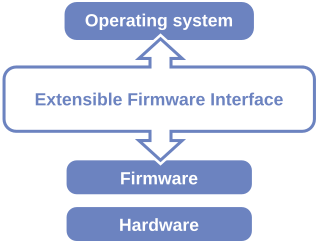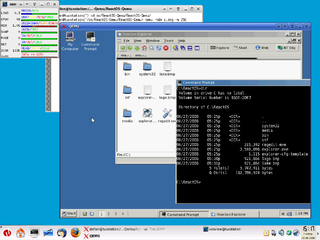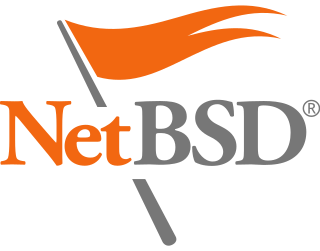Related Research Articles

A Linux distribution is an operating system made from a software collection that includes the Linux kernel and, often, a package management system. Linux users usually obtain their operating system by downloading one of the Linux distributions, which are available for a wide variety of systems ranging from embedded devices and personal computers to powerful supercomputers.
DNIX is a discontinued Unix-like real-time operating system from the Swedish company Dataindustrier AB (DIAB). A version called ABCenix was also developed for the ABC 1600 computer from Luxor.

QNX is a commercial Unix-like real-time operating system, aimed primarily at the embedded systems market. QNX was one of the first commercially successful microkernel operating systems. As of 2020, it is used in a variety of devices including cars and mobile phones.

FreeDOS is a free operating system for IBM PC compatible computers. It intends to provide a complete MS-DOS-compatible environment for running legacy software and supporting embedded systems.

Damn Small Linux (DSL) was a computer operating system for the x86 family of personal computers. It is free and open-source software under the terms of the GNU GPL and other free and open source licenses. It was designed to run graphical user interface applications on older PC hardware, for example, machines with 486 and early Pentium microprocessors and very little random-access memory (RAM). DSL is a Live CD with a size of 50 megabytes (MB). What originally began as an experiment to see how much software could fit in 50 MB eventually became a full Linux distribution. It can be installed on storage media with small capacities, like bootable business cards, USB flash drives, various memory cards, and Zip drives.

BusyBox is a software suite that provides several Unix utilities in a single executable file. It runs in a variety of POSIX environments such as Linux, Android, and FreeBSD, although many of the tools it provides are designed to work with interfaces provided by the Linux kernel. It was specifically created for embedded operating systems with very limited resources. The authors dubbed it "The Swiss Army knife of Embedded Linux", as the single executable replaces basic functions of more than 300 common commands. It is released as free software under the terms of the GNU General Public License, version 2.

The Unified Extensible Firmware Interface (UEFI) is a publicly available specification that defines a software interface between an operating system and platform firmware. UEFI replaces the legacy Basic Input/Output System (BIOS) firmware interface originally present in all IBM PC-compatible personal computers, with most UEFI firmware implementations providing support for legacy BIOS services. UEFI can support remote diagnostics and repair of computers, even with no operating system installed.

A diskless node is a workstation or personal computer without disk drives, which employs network booting to load its operating system from a server.

QEMU is a free and open-source hypervisor. It emulates the machine's processor through dynamic binary translation and provides a set of different hardware and device models for the machine, enabling it to run a variety of guest operating systems. It can interoperate with Kernel-based Virtual Machine (KVM) to run virtual machines at near-native speed. QEMU can also do emulation for user-level processes, allowing applications compiled for one architecture to run on another.
The NSLU2 is a network-attached storage (NAS) device made by Linksys introduced in 2004 and discontinued in 2008. It makes USB flash memory and hard disks accessible over a network using the SMB protocol. It was superseded mainly by the NAS200 and in another sense by the WRT600N and WRT300N/350N which both combine a Wi-Fi router with a storage link.
TrueNAS is the branding for a range of free and open-source network-attached storage (NAS) operating systems produced by iXsystems, and based on FreeBSD and Linux, using the OpenZFS file system. It is licensed under the terms of the BSD License and runs on commodity x86-64 hardware.

FreeBSD is a free and open-source Unix-like operating system descended from the Berkeley Software Distribution (BSD), which was based on Research Unix. The first version of FreeBSD was released in 1993. In 2005, FreeBSD was the most popular open-source BSD operating system, accounting for more than three-quarters of all installed simply, permissively licensed BSD systems.
muLinux was an Italian, English-language lightweight Linux distribution maintained by mathematics and physics professor Michele Andreoli, meant to allow very old and obsolete computers to be used as basic intranet/Internet servers or text-based workstations with a UNIX-like operating system. It was also designed for quickly turning any 80386 or later computer into a temporary, powerful Linux machine, along with system repair, education, forensic analysis and what the developer called proselytizing. In 2004 reviewer Paul Zimmer wrote, "Although there are several other single-floppy Linux distributions, none can match muLinux's extensive and unique combination of useful features." The last version update was in 2004, when further development of this "linux-on-a-floppy" distribution ended.

The SheevaPlug is a "plug computer" designed to allow standard computing features in as small a space as possible.
The ICL DRS was a range of departmental computers from International Computers Limited (ICL). Standing originally for Distributed Resource System, the full name was later dropped in favour of the abbreviation.

NetBSD is a free and open-source Unix-like operating system based on the Berkeley Software Distribution (BSD). It was the first open-source BSD descendant officially released after 386BSD was forked. It continues to be actively developed and is available for many platforms, including servers, desktops, handheld devices, and embedded systems.

OpenMediaVault (OMV) is a free Linux distribution designed for network-attached storage (NAS). The project's lead developer is Volker Theile, who instituted it in 2009. OMV is based on the Debian operating system, and is licensed through the GNU General Public License v3.

XigmaNAS is network-attached storage (NAS) server software with a dedicated management web interface. It is free software under the terms of the Simplified BSD license.
References
- ↑ "NanoBSD man page". The FreeBSD Project. Retrieved 24 Aug 2014.